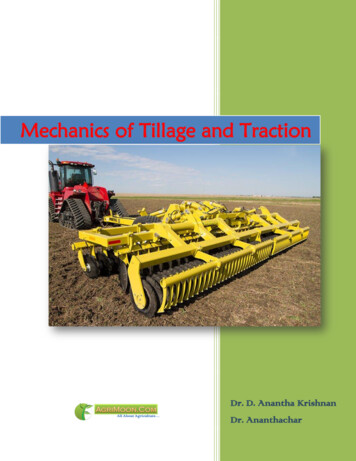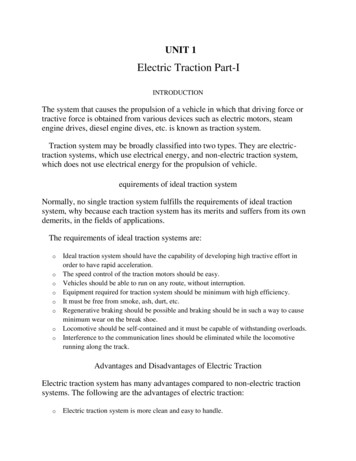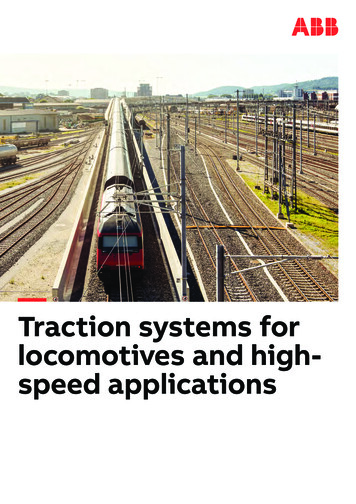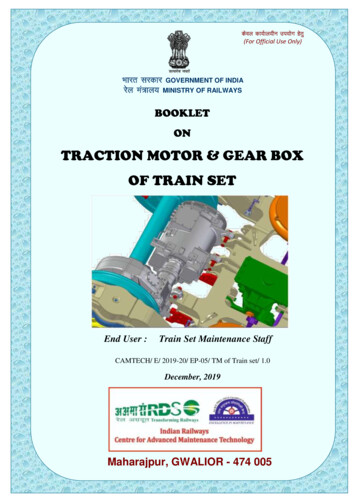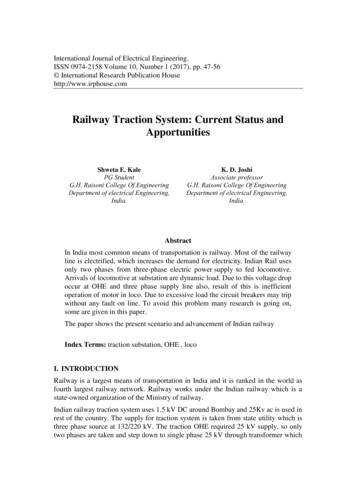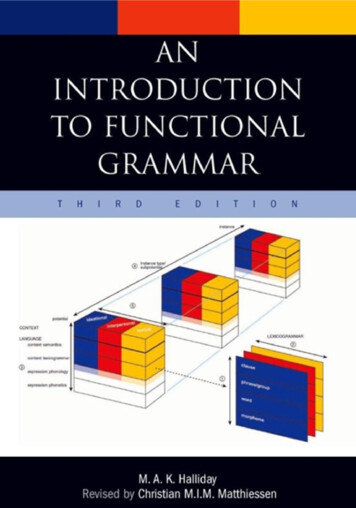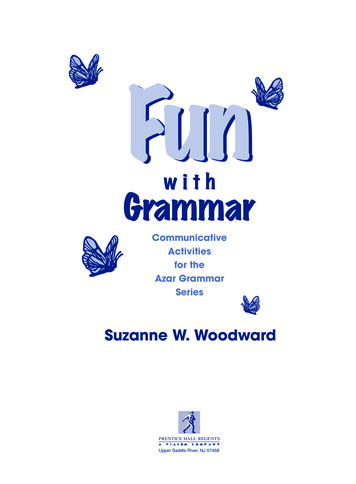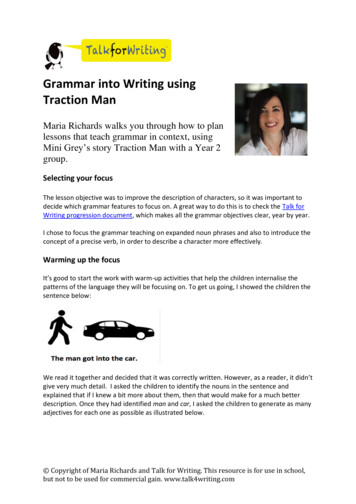
Transcription
Grammar into Writing usingTraction ManMaria Richards walks you through how to planlessons that teach grammar in context, usingMini Grey’s story Traction Man with a Year 2group.Selecting your focusThe lesson objective was to improve the description of characters, so it was important todecide which grammar features to focus on. A great way to do this is to check the Talk forWriting progression document, which makes all the grammar objectives clear, year by year.I chose to focus the grammar teaching on expanded noun phrases and also to introduce theconcept of a precise verb, in order to describe a character more effectively.Warming up the focusIt’s good to start the work with warm-up activities that help the children internalise thepatterns of the language they will be focusing on. To get us going, I showed the children thesentence below:We read it together and decided that it was correctly written. However, as a reader, it didn’tgive very much detail. I asked the children to identify the nouns in the sentence andexplained that if I knew a bit more about them, then that would make for a much betterdescription. Once they had identified man and car, I asked the children to generate as manyadjectives for each one as possible as illustrated below. Copyright of Maria Richards and Talk for Writing. This resource is for use in school,but not to be used for commercial gain. www.talk4writing.com
Adjectives to gowith manAdjectives togo with carWe then looked at this more closely. I explained that when we add adjectives to a nounphrase like the man, we get an expanded noun phrase, for example: the old man. Welooked at a few more examples, practised saying them and wrote some on whiteboards.We then focused on improving the verb to make it more precise and descriptive. Instead ofThe man got into the car, what else could we have instead of got? The children talked totheir partners for ideas, then we did quick-fire feedback. They gave me as many ideas asthey could in one minute round the group. For example:The man: jumped, fell, raced, squeezed, lumbered, flew, ran, tiptoed, danced, crept intothe car.By being more precise with the verbs, we are telling our reader more about the characterand what they do, say or how they behave.Introducing the stimulusI then introduced the children to Traction Man by Mini Grey. The story shows us TractionMan’s many missions, whom he defeats and what he wears when doing so! I explained thatMini uses great examples of expanded noun phrases all the way through the story and Ipointed out the first few. Then as I read to the class, the children raised their hands everytime they heard an expanded noun phrase. I also challenged the teacher, who was workingwith me, to collect as many expanded noun phrases as they could on the flipchart and this iswhat we got: Copyright of Maria Richards and Talk for Writing. This resource is for use in school,but not to be used for commercial gain. www.talk4writing.com
I stopped reading at the part of the story where granny has given Traction Man a new outfitto go into the jungle. I asked the children to imagine what he might encounter if he were togo to the jungle in his new romper suit. Mini Grey Copyright of Maria Richards and Talk for Writing. This resource is for use in school,but not to be used for commercial gain. www.talk4writing.com
I showed the children how this might work in the story by adding to this page, which gave usthe opportunity to create a new scene for the story. Mini GreyAfter a brief discussion, I then introduced a new character for Traction Man to defeat.Applying the grammarThe idea was to use the visual stimulus to write creative sentences about what the characterlooked like and did, using the expanded noun phrases and specific verbs. This way, wewould be applying the grammar for the purpose of enhancing character description beyondthe obvious e.g. The tiger had black and orange stripes. Copyright of Maria Richards and Talk for Writing. This resource is for use in school,but not to be used for commercial gain. www.talk4writing.com
In order to do this we looked at each noun phrase separately and generated the adjectivesto expand itWe took each noun in turn and we craftedsentences together. I showed the childrenhow to raid each list to find the bestadjectives to expand the noun and keptdropping in the terminology, so that by theend of the writing, they had heard me referto ‘expanding the noun phrase’, ‘nounphrases’ and ‘precise/interesting verb,’ anumber of times.Throughout the writing I was discussing what worked well and why, with the children andsupported them in making the choices to get the best descriptions possible. We choseadjectives to best match the type of character we wanted – fierce. Equally, we could havecreated a happy tiger, yawning and munching!Here is an example of what we created:The TigerThe fierce tiger growls.Its dagger teeth ready to tear.The thin, wiry whiskers slice throughthe air like fireworks.A blood-red nose spies for prey.The deadly, jagged stripes criss-crossover its colourful body.The hungry tiger waits. Copyright of Maria Richards and Talk for Writing. This resource is for use in school,but not to be used for commercial gain. www.talk4writing.com
To end the session, I wanted to show the children how they could then raid their descriptivesentences and drop them into this new part of the story. We went back to the page whereTraction Man is in the jungle and added the line Out of nowhere I then told the children the next part of the story, adding in the new character:Out of nowhere, a fierce tiger appeared with its dagger teeth ready to tear. Itgrowled at the strangers. Traction Man noticed its thin, wiry whiskers slicingthe air like fireworks. It had a blood-red nose that spied into every corner,searching for prey. From his Supersonic Space-cup, he could see its deadly,jagged stripes criss-crossing its colourful body. The hungry tiger stalked thejungle and waited beneath the colossal tree where Traction Man had landed.What could he do?If I had longer with the groups, I would have used shared writing to craft this bit with them,showing them how and where to place the sentences, to make them into a successfulparagraph.What next?Over a series of lessons, the children can use this method to create their own descriptivesentences about the tiger, using the class brainstorm. They could then write a paragraphwhere they put the tiger into the scene.Following this, they can choose another character that Traction Man might encounter on hismissions and write about them, using the same process. They could write the sequel toTraction Man, where he goes on more missions and encounters or defeats new charactersalong the way – all underpinned by this process. The characters created would be the Copyright of Maria Richards and Talk for Writing. This resource is for use in school,but not to be used for commercial gain. www.talk4writing.com
stimulus for the new writing (this could be an innovation or even a stimulus for theindependent application).Other areas to focus onOf course, this idea can also be used to describe other aspects of a story. We could haveused it to craft what the jungle looked like and, therefore, focus on setting. For this,depending on where the children are and what they need to move forward, we could haveexplored any of the following grammar: Prepositions – to place things within a setting e.g. Twisted vines crawled overbranches.Similes using like – to give the reader a more vivid picture of what’s there e.g.Twisted vines crawled over branches, like hungry vipers.Relative clauses to add detail about the things within the setting e.g. Twisted vines,which were cracked and gnarled, crawled over branches.Expanded noun phrases, using two adjectives, to describe objects within the settinge.g. The ancient, twisted vines hung from the trees.The use of the continuous verb form to show how things behave in the setting or areplaced in the setting e.g. Twisted vines were hanging from ancient branches.Again, using a visual stimulus we could brainstorm the vocabulary needed, craft thedescriptive sentences (underpinned by the grammar) and then drop them into a descriptiveparagraph. The same idea would also work if we wanted to focus on the description ofobjects in a story.This idea can be adapted for any grammar focus, age group and book and is just anothertool to support the creative teaching of grammar, through reading and writing in context.With thanks to teachers Hannah Morini and Year 2 at St Mary’s CE VC Primary School,Bridport, Dorset and to Ben Straker and class 2 at St Thomas Cantilupe C of E Academy,Hereford, for lending me their children and working alongside me.Maria RichardsTalk for Writing Primary ExpertMaria Richards is available to deliver training throughout the UK &internationally. Please visit the training page on the Talk for Writingwebsite for more details. Want a project to run in your area?Contact Maria for details. maria.richards@talk4writing.com Copyright of Maria Richards and Talk for Writing. This resource is for use in school,but not to be used for commercial gain. www.talk4writing.com
Traction Man is in the jungle and added the line Out of nowhere I then told the children the next part of the story, adding in the new character: Out of nowhere, a fierce tiger appeared with its dagger teeth ready to tear. It growled at the strangers. Traction Man noticed its thin, wiry whiskers slicing the air like fireworks.
